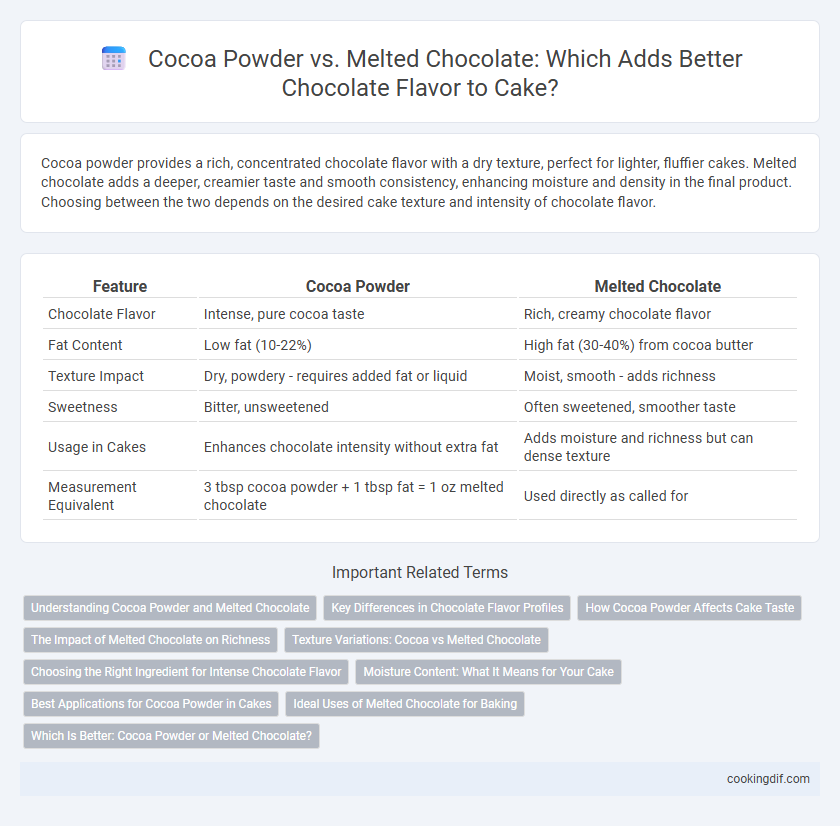Cocoa powder provides a rich, concentrated chocolate flavor with a dry texture, perfect for lighter, fluffier cakes. Melted chocolate adds a deeper, creamier taste and smooth consistency, enhancing moisture and density in the final product. Choosing between the two depends on the desired cake texture and intensity of chocolate flavor.
Table of Comparison
| Feature | Cocoa Powder | Melted Chocolate |
|---|---|---|
| Chocolate Flavor | Intense, pure cocoa taste | Rich, creamy chocolate flavor |
| Fat Content | Low fat (10-22%) | High fat (30-40%) from cocoa butter |
| Texture Impact | Dry, powdery - requires added fat or liquid | Moist, smooth - adds richness |
| Sweetness | Bitter, unsweetened | Often sweetened, smoother taste |
| Usage in Cakes | Enhances chocolate intensity without extra fat | Adds moisture and richness but can dense texture |
| Measurement Equivalent | 3 tbsp cocoa powder + 1 tbsp fat = 1 oz melted chocolate | Used directly as called for |
Understanding Cocoa Powder and Melted Chocolate
Cocoa powder offers a concentrated chocolate flavor with less fat, enhancing the cake's cocoa intensity and providing a dry texture, while melted chocolate contains cocoa solids paired with cocoa butter, contributing richness and moisture. Understanding the difference is crucial, as cocoa powder intensifies chocolate taste without adding fat, whereas melted chocolate adds smoothness and depth due to its fat content. The choice between cocoa powder and melted chocolate impacts cake texture, flavor profile, and richness, making them distinct ingredients for chocolate flavoring in baking.
Key Differences in Chocolate Flavor Profiles
Cocoa powder delivers a deep, intense chocolate flavor with a slightly bitter and dry finish, ideal for adding richness without extra fat. Melted chocolate offers a smoother, creamier taste due to its cocoa butter content, resulting in a more luxurious texture and sweeter flavor profile. Choosing between cocoa powder and melted chocolate significantly affects the cake's overall moisture, texture, and depth of chocolate taste.
How Cocoa Powder Affects Cake Taste
Cocoa powder contributes a rich, intense chocolate flavor with a slightly bitter undertone that enhances the complexity of cake taste. It absorbs more moisture than melted chocolate, often resulting in a denser, fudgier texture while intensifying the dark chocolate notes. Using cocoa powder allows for greater control over sweetness and chocolate concentration, making it ideal for achieving a deep, bold flavor profile in cakes.
The Impact of Melted Chocolate on Richness
Melted chocolate contains cocoa butter, which enhances the cake's richness and provides a smoother, creamier texture compared to cocoa powder. The fat content in melted chocolate intensifies the chocolate flavor, creating a more decadent and moist crumb. Cocoa powder, lacking cocoa butter, offers a sharper chocolate taste but may result in a drier, less rich cake.
Texture Variations: Cocoa vs Melted Chocolate
Cocoa powder imparts a lighter, drier texture to cakes due to its lack of fat, resulting in a more crumbly and tender crumb. Melted chocolate contains cocoa butter, contributing moisture and richness, which creates a denser, fudgier texture with a velvety mouthfeel. Choosing between cocoa powder and melted chocolate directly influences the cake's overall softness and structural density.
Choosing the Right Ingredient for Intense Chocolate Flavor
Cocoa powder offers a concentrated chocolate flavor with less fat, providing a rich, deep taste ideal for dense, fudgy cakes. Melted chocolate contributes both flavor and fat, creating a smoother, creamier texture while delivering a more mellow chocolate intensity. For an intense chocolate flavor, combining high-quality cocoa powder with a smaller amount of melted chocolate can balance richness and moisture effectively.
Moisture Content: What It Means for Your Cake
Cocoa powder delivers a rich chocolate flavor with low moisture content, resulting in a denser, drier cake crumb. Melted chocolate contains fats and some moisture, which adds richness and contributes to a moist, tender texture. Choosing between the two affects both the intensity of chocolate flavor and the cake's overall moisture balance.
Best Applications for Cocoa Powder in Cakes
Cocoa powder is ideal for cakes requiring a deep chocolate flavor without added fat, offering a rich, intense taste with a lighter texture compared to melted chocolate. It performs best in recipes like chocolate sponge cakes, brownies, and devil's food cake where moisture control and a tender crumb are essential. Using cocoa powder also allows for better leavening action since it does not introduce extra fat, helping cakes rise more evenly.
Ideal Uses of Melted Chocolate for Baking
Melted chocolate is ideal for adding a rich, intense chocolate flavor and smooth texture to batters, frostings, and ganaches in baking. It incorporates seamlessly into recipes like brownies, chocolate cakes, and truffles, providing a glossy finish and deep cocoa taste. Unlike cocoa powder, melted chocolate delivers both flavor and fat content, enhancing moisture and mouthfeel in baked goods.
Which Is Better: Cocoa Powder or Melted Chocolate?
Cocoa powder delivers a concentrated, intense chocolate flavor with lower fat content, making it ideal for light, airy cakes and enhancing crumb texture. Melted chocolate, enriched with cocoa butter, offers a richer, creamier taste and denser texture, perfect for moist, decadent cakes and ganache fillings. Choosing between cocoa powder and melted chocolate depends on the desired cake flavor intensity, texture, and fat balance for your recipe.
Cocoa powder vs Melted chocolate for chocolate flavor Infographic

 cookingdif.com
cookingdif.com